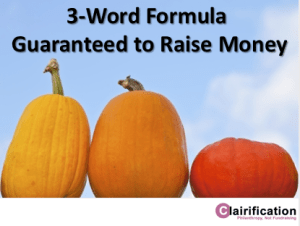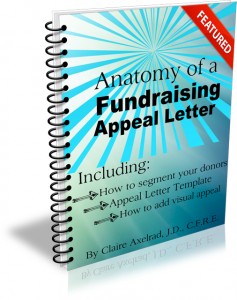 I consider these three words the holy trinity of fundraising success.
I consider these three words the holy trinity of fundraising success.
They are simple.
They are easy to remember.
They really work.
Plus, if you wrap them up with some emotional color, you’ve got an offer that can’t be refused.
Let’s take a look.
YOU.
Did you know that “you” is one of the five most powerful words in the English language?
Make philanthropy about your donor’s experience.
Use “you” rather than “I” or “our” or “we” (unless it’s “we, together”). Cross out all the ego-centric stuff in your copy and rewrite.
As veteran communicator Tom Ahern says”you is the glue.”
You grabs your donor’s attention.
You is “sticky.”
You helps to “tip” your donor towards seeing your request in a positive light.
You makes the story you tell about your donor.
Make fulfilling your organization’s mission about your donor’s actions. Make the values your organization enacts about your donor’s caring, generosity and good character.
Use “you” to make your donor the hero.
Show your donor how to be the very best version of themselves.
- “You can do this.”
- “You did this.”
- “Your commitment will make this happen.”
- “You are magic… powerful… extraordinary… unselfish… honorable… wise… far-seeing…
Instead of “We cure cancer” or “Our organization cures cancer” or “They cure cancer,” substitute “You” and “Your.”
Speak to your donor personally.
Be flattering.
Assume their best qualities.
Allow your donor to rise to the occasion.
BECAUSE.
I thought my Mom was crazy when she said “do this because I said so” to me.
Who knew there was method to her madness?!
Guess what?
Neuroscience studies show this magic word can make any statement more persuasive.
One of the most interesting studies, reported by Harvard Magazine, revealed that as a trigger for acquiescence, the word “because” increased the success rate by over 30%.
I found this freaking amazing when I learned it, and I’ve used it ever since.
It turns out that “because” is one of the persuasion principles that help explain the psychology of why people say “yes” without thinking. The human brain is wired to react when it hears because.
It is a magical word — an automatic trigger for compliance.
Sure, you can get a yes without using this little tip. You can get people to think and consider your appeal and still make a contribution. But if you can boost your chance by 30%, wouldn’t that be a very smart thing to do?
Here are some examples of how to use “because”:
- Instead of “Today I’m sharing Amelia’s story with you.”
- Say “Today I’m sharing Amelia’s story with you because she needs your help.”
- Instead of “Yes, I want to give.”
- Say “Yes, I want to give because children need me.”
- Instead of “Please consider a gift of $500.”
- Say “Please consider a gift of $500 because children need your help.”
- Instead of “Provide a meal to a starving child.”
- Say “Provide a meal because Miguel is starving.”
You can do this to almost any sentence.
It seems almost ridiculous, yet the research reveals the way people respond is often somewhat mindless, based more upon the familiar framework within which a request is made than on the content.
Using the word “because” triggers that familiarity framework. It gives folks an explicitly expressed reason to do something, rather than an implied reason.
This sets the stage that kicks in the psychology of unconscious social inference.
The difference is subtle, yet the impact is pronounced.
THANKS.
There is a magical power behind the word “thanks.”
It puts people in a receptive mood.
It’s considered good manners, and makes you look like a good and giving person.
Simply put, it makes folks like you.
Penelope Burk’s groundbreaking research on donor retention found that the three principle things donors want from charities all have to do with thank you. They want to be thanked (1) promptly, (2) personally, and (3) in a manner that reflects back the impact of their giving.
The thank you process will be the single biggest indicator of your donor’s likelihood to give again.
But don’t just save the word “thanks” for your acknowledgement letters.
When you thank donors in your appeal letters for their past giving, it also reminds them they already made a decision to give to you. This triggers one of Cialdini’s six principles of persuasion – commitment and consistency. We tend to repeat decisions we’ve already made because doing so is congruent with our self-image.
When you thank prospects in your appeal letters for being caring people, it plays into the vision of the person they would like to see when they look into the mirror.
Saying thanks to folks flatters them and plays to their ego.
Recipe for Success!
“You.” “Because.” and “Thanks.”
The holy trinity of fundraising writing!
Begin and end with these staples, and you’ll be well on your way to an appeal your donor’s won’t want to refuse.
Now let’s add a bit of spice to this recipe with…
EMOTIONAL COLOR.
You can add a lot of color with your words. No magic markers required.
And no need to add a bunch of adverbs and adjectives.
Just write in a manner that lets readers know how your protagonist — the person they can help, heal, rescue, save and otherwise raise up with their gift — feels about their situation.
It’s only by sharing emotion that you can get your donor to empathize with that emotion.
And empathy is what motivates philanthropic action.
Let’s look at an example I’m borrowing from Sean D’Souza of Psychotactics.com who writes about How To Correctly Use Emotion To Create Drama. Sean’s blog is not about fundraising per se, but his tagline is “Why Customers Buy (and Why They Don’t).”
Want your donors to “buy” what you’re selling? Then read on.
Take a look at the following sentences.
- She saw the bowl of soup.
- She saw the bowl of soup and her heart sank.
- She saw the bowl of soup and it flooded her with happy childhood memories.
- She saw the bowl of soup and was overcome with how hungry she felt.
- She saw the bowl of soup, but a feeling of hesitancy crept into her being.
- She saw the bowl of soup, and immediately felt overwhelmed.
What’s the difference between the first sentence and those that follow?
If you’re telling a story, the “things” — like the bowl of soup — aren’t what your reader’s brain is searching for. Their brain is searching for the expression on your protagonist’s face — and what that expression means. What’s her mood? What difficulties is she encountering? Is her situation causing her to feel anger? Despair? Nostalgia? Frustration? Exhaustion? Hopelessness? Depression?
Even if you have a great photo of a woman with a bowl of soup, your prospective donor needs to know what this signifies. Why is it important?
You add the emotional meaning through your words. They may be words in the photo caption. Or words that precede or follow your main statement.
- Emotion sets the scene.
- Emotion leads the reader through the rest of the letter or article.
- Emotion helps the reader empathize with the situation.
Because many people can drink soup.
But each one will feel totally differently about the soup, depending upon how you color the situation.
Just like the holy trinity of “You,” “Because,” and “Thanks,” emotional words add the color and spice that cause what is read and said to “stick.”
Use your 3 key words and colors generously.
I promise you’ll reap generous rewards.
Tom Belford recently shared a wonderful example from Charity: Water on the Agitator blog. It happens to be a thank you to volunteers, rather than an appeal. It could easily be either.
Check out this email subject line:
Because. Of you.
Wondering where the thanks is to complete the trinity?
When you open the email, you receive a thank you video.
The emotional color? Watch the video!
Go forth and cook up a great appeal — just be sure you follow the recipe!
And if you have any examples you’re willing to share with me, I’d love to see them. Thank You.
Want More to Guarantee Your Appeal Raises More Money?

This 62-page e-Guide is a surprisingly quick read — and a true road map to creating a winning fundraising appeal
Get my Anatomy of a Fundraising Appeal + Sample Template — a thorough e-Guide with everything you need to put together an offer your prospect can’t possibly refuse!
This is super practical stuff I’ve learned over the past 30+ years. Plus I’ll explain to you why I’m suggesting you take the recommended actions — so if anyone tries to dissuade you from doing what you know works, you’ll have the ammunition you need to stick to your guns. That’s how you’ll raise more money.
Grab it here! I guarantee you’ll raise way more than the modest cost of this Guide — or I’ll make a donation to your nonprofit!
Top images courtesy of Freedigitalphotos.net; Last image courtesy of Creative Commons, Flickr.
A version of this article appeared on Clairification in November, 2015









